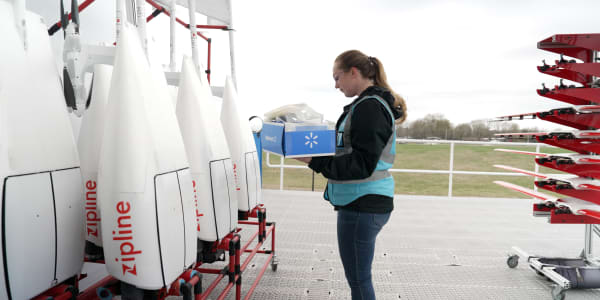Pinterest believes it can reinvent the wheel when it comes to discovering things online, both for users and advertisers alike.
"What we're basically trying to do for discovery is what Google did for search," said Pinterest president Tim Kendall. "When you're looking for something you don't know how to describe or even something you don't know what you're looking for in travel or food, we want to be the place you go when things are super open-ended for you."
The company, which has an $11 billion valuation, according to DealBook, thinks it can also offer something different for brands as well. With its strengths in visual search, data targeting and a clear sales attribution model, it has a unique ability to introduce products to customers.
"We're often the first time a brand gets in front of a customer," Kendall said. "We're trying to prove that if you get the first touch, it's the most valuable touch."
A different social media audience
Pinterest, which ranks number 31 on CNBC's 2017 Disruptor 50 list, declined to disclose its revenue.
However, CEO Ben Silbermann publicly said the company generated about $300 million in 2016, according to the Wall Street Journal. Recode reported sources said Pinterest believes it can reach $500 million this year, and some sources say it can top $600 million.
Massive user growth is driving that revenue. Pinterest claims 175 million monthly active users, up from 10 million in 2010. Most of those users joined in the last two years, Pinterest added. It's users have created upwards of 100 billion pins, and there are more than 2 billion boards.
The majority of users are female, Pinterest's Kendall acknowledges. When Kendall, who was previously the director of monetization for Facebook, started with the company five years ago, the base was 90 percent female. Today it's about 70 percent female, with international more balanced at 60/40.
"We're starting to see that shift to a more balanced ratio," Kendall said. "I don't think it's a problem, because it's moving in the right direction, and to your point, females are a valuable customer."
It's very simple to learn how to use Pinterest, which helps it appeal to users of all ages — a sharp contrast to the millennials and teens who dominate Snapchat. App analytics company App Annie found 40 percent of Android Pinners were over 45 years old, and another 40 percent were between 25 and 44.
On iPhones, users skewed 25 to 44, but again the second-biggest group was over 45. Those under 24 made up the smallest portion of users.
The fact that it has a different base from Snapchat could work to its benefit. Widespread use among peers was one of the factors that lead advertisers and investors to Facebook, many have noted.
"Snap makes itself challenging to use," said eMarketer principal analyst Debra Aho Williamson. "I think that's what appeals to young people. Pinterest got its start being aimed toward Midwestern moms. That has continued. Young women to middle-aged women are the primary users. It has to be easy to use. For that audience that's a benefit."
Pinterest knows that it has a premium audience, and sources say it is charging accordingly. For example, most platforms charge between 30 cents and 50 cents per user to show ads that get users to install apps, a source noted. However, for Pinterest it's in the dollars-per-user range. Pinterest declined to comment on the pricing.
"Their mobile experience has allowed for a more casual experience, which is really important as it pertains to advertising for categories like weddings or fitness, but that pool is limited," said Jonathan Kay, the chief operating officer of app analytics company Apptopia. "In order to have a successful advertising business, it's kind of limited. But the mobile app has unlocked potential."
But Pinterest's users is they are prime users that advertisers crave, said Kay. Three-quarters of Pinners use the top-grossing apps, and around a third of them use Wish, Etsy and/or eBay on their phones. They're very comfortable spending on in-app purchases, Kay said.
"They didn't fit the profile of the stereotypical social media app user," Kay said. "The Pinterest user is comfortable spending money in mobile, which is probably the single most important think you should take away from this."
Why Pinterest ads are different
Let's say you're retailer Land of Nod and you want to advertise your strollers, Pinterest's Kendall explained.
Most search and some social media ads target based on keywords, meaning the majority of your customers already were intending to purchase a Land of Nod stroller. In essence, the advertiser is double-paying for a customer that was likely to buy their product. If you place your ad next to your competitor's stroller, you have to pay more to convince the consumer not to buy their stroller and get them to buy yours.
That's where Pinterest is different, Kendall said. The platform conducts more than 2 billion searches based on terms every month, and 97 percent of them are unbranded, like green velvet couch, wedding photographer or stroller. (It also completes 250 million visual searches.)
"We can go to Land of Nod [and tell them] we can get you lots of people searching for strollers," Kendall said. "We're offering you this customer at the perfect time. They want a stroller, and they haven't decided who to go with. Think of it as the opportunity to be at the perfect point of getting in front of the customer."
When you're looking for something you don't know how to describe or even something you don't know what you're looking for in travel or food, we want to be the place you go when things are super open-ended for you.Tim KendallPinterest president
On top of that, Pinterest has third-party partners to confirm if the ads were actually seen by a human and how many people viewed them, and it will add audience verification soon, a source with knowledge of the matter added. And because people go to Pinterest to pin things they want to buy, it's easier for them to show if a click really did indeed lead to a purchase.
"Marketers are demanding that all digital marketing channels be held more accountable for everything from ad fraud to ad-delivery transparency to better measurement," said Forrester senior analyst Jessica Liu. "Pinterest is not an exception to this rule. They're in a good position because their platform is intent-based, making it easier for Pinterest to link their ad products to consumer actions. But they will still be held to the same expectations as other digital platforms, and the collective industry has much work to do to prove efficacy."
Pinterest faces stiff competition for those ad dollars, though. The two giants of online advertising, Google and Facebook, account for up to 73 percent of the digital ad market, according to eMarketer's 2017 projections. Other online companies with giant audiences, like Alibaba, Baidu and Tencent, are expected to take in $18.12 billion, $10.23 billion and $7.47 billion, respectively, this year. Even Snap is expected to reach the billionaire's club by 2018.
Many outsiders have criticized Pinterest for being slow to ramp up its advertising efforts, but Kendall points out it added 27 new features for advertisers just in the latter half of 2016, including new ad formats, more targeting, more back-end tools and more proof of return on investment. He truly believes the company is doing something different, and it will pay off in the future as advertisers move more money from offline formats to digital.
""I know that's the broken record of digital advertising, but a lot of money is still in TV and radio," said Kendall. "I think the reason why it's still there is nobody has quite yet figured out how to do demand generation at scale online. They demanded how to do demand inception, which is great. I think we're in the best position to do demand generation."








